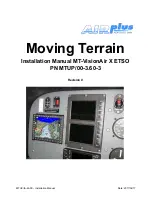
resulting numbers to calculate the magnitude of the vibration signal. This
magnitude is reported as a peak velocity in units of Inches Per Second (IPS).
The accelerometer senses the magnitude of the vibration but more information
is required to carry out the balancing process. This is because it is not
sufficient to know just the magnitude of the vibration signal. It is also necessary
to know the
phase of that signal. The phase of the signal is the relationship
of the signal waveform to the angular position of the propeller. Given the phase
information, it is possible to determine where the weight is required to be
added to reduce the vibration. By detecting when one particular propeller blade
passes an optical sensor, the balancer can measure and report the phase of
the vibration waveform. The optical sensor also works as a tachometer to
measure the propeller RPM.
7.5. Taking a vibration reading
Warning
Propellers can kill.
Make sure that the engine ignition is switched off before touching
the propeller.
Always assume that the engine could fire when the propeller is
being moved.
Make sure that the aircraft is securely chocked or tied down while
carrying out the balancing process.
Please see the
for a description of the PB-4 sensors
and how they are attached to the aircraft.
For maximum accuracy, the dynamic balancing process should only be carried
out in light winds. Ideally, the wind should be less than 5 kts. The aircraft
should be positioned so that it is pointing into any wind.
Important
Before you start the engine, check that the
are all set
appropriately. Propeller mode should be selected and the point
smoothing, number of weight sites and PSRU ratio set to suitable
values.
Make sure the engine is thoroughly warm before taking any readings.
Firstly, you need to decide what propeller RPM you are going to use while
balancing. For a typical propeller, an RPM in the range 1500-2000 is often a
good choice. Using the
, observe the movement of the current polar
point. If you think it is necessary, adjust the throttle to find the RPM that
45
www.smartavionics.com
Taking a vibration reading
Summary of Contents for PB-4
Page 6: ...www smartavionics com vi...
Page 12: ...www smartavionics com 6...
Page 20: ...www smartavionics com 14...
Page 34: ...www smartavionics com 28...
Page 40: ...www smartavionics com 34...
Page 56: ...www smartavionics com 50...
Page 62: ...www smartavionics com 56...
Page 68: ...www smartavionics com 62...
Page 70: ...www smartavionics com 64...
Page 74: ...www smartavionics com 68...
Page 78: ...www smartavionics com 72...










































